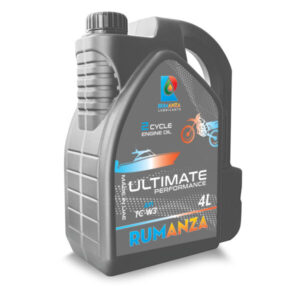Choosing the Right Rumanza 2 Stroke TC-W3 Oil for Your Needs
Understanding TC-W3 Certification: Why It’s Crucial for Your Engine
The TC-W3 standard, established by the National Marine Manufacturers Association (NMMA), is the highest performance rating for 2-stroke marine oils. But what does this certification actually mean for your engine?
Key Performance Tests for TC-W3 Certification
To earn TC-W3 approval, oils must pass rigorous testing, including:
Lubricity Test – Measures protection against piston scuffing and ring wear.
Detergency Test – Evaluates ability to prevent carbon deposits and sludge.
Rust & Corrosion Test – Ensures protection in humid/saltwater environments.
Smoke & Emissions Test – Confirms low pollution output for environmental compliance.
Why Rumanza TC-W3 Oil Stands Out:
Superior film strength to prevent metal-to-metal contact.
Advanced detergent additives to keep pistons and rings clean.
Low-ash formulation to reduce spark plug fouling.
TC-W3 vs. Other Standards (TC-WII, JASO, API)
TC-WII (Older Standard) – Lacks the advanced detergency and rust protection of TC-W3.
JASO-FB/FC (Motorcycle Oils) – Not optimized for marine use; may fail in water-cooled engines.
API-TC (General 2-Stroke Oil) – No specific marine protection; risk of corrosion.
Bottom Line: If your engine requires TC-W3, using a non-certified oil can lead to premature wear, carbon buildup, or even engine seizure.
Rumanza’s TC-W3 Oil Lineup: Which One is Right for You?
Rumanza offers three primary formulations, each designed for different engine types and operating conditions.
A. Mineral-Based Rumanza TC-W3 Oil
Best for: Older 2-stroke engines, low-RPM applications, budget-conscious users.
Technical Breakdown:
Base Oil: Refined petroleum with basic additives.
Viscosity: Stable across moderate temperatures.
Additives: Standard detergents and anti-wear agents.
Pros:
✔ Cost-effective
✔ Good lubrication for standard engines
Cons:
✖ More smoke and deposits than synthetics
✖ Less stable in extreme temperatures
Ideal Applications:
Vintage outboard motors
Small garden tools (weed trimmers, chainsaws)
B. Semi-Synthetic Rumanza TC-W3 Oil
Best for: Mixed-use engines (marine + recreational), moderate performance demands.
Technical Breakdown:
Base Oil: Blend of mineral and synthetic hydrocarbons.
Viscosity: Improved cold-start performance.
Additives: Enhanced detergents, anti-oxidants, and corrosion inhibitors.
Pros:
✔ Better cleanliness than mineral oil
✔ Reduced smoke and deposits
✔ Good value for performance
Cons:
✖ Slightly more expensive than pure mineral oil
Ideal Applications:
Mid-range outboard motors
Dirt bikes and ATVs
Snowmobiles
C. Full Synthetic Rumanza TC-W3 Oil
Best for: High-performance engines, extreme conditions, racing.
Technical Breakdown:
Base Oil: 100% synthetic hydrocarbons (PAO or ester-based).
Viscosity: Ultra-stable at high RPMs and temperatures.
Additives: Premium anti-wear (ZDDP), advanced detergents, and water-repellent agents.
Pros:
✔ Maximum engine protection
✔ Minimal carbon buildup
✔ Excellent cold-weather flow
Cons:
✖ Highest cost (but extends engine life)
Ideal Applications:
High-performance marine engines (e.g., racing boats)
Competition motorcycles
Turbocharged 2-stroke engines
How to Choose the Best Rumanza Oil for Your Engine
Step 1: Check Your Engine Manual
Look for TC-W3 compliance requirement.
Verify the recommended oil type (mineral, semi-synthetic, or full synthetic).
Step 2: Consider Your Operating Conditions
| Condition | Best Rumanza Oil Choice |
|---|---|
| Saltwater Use | Full Synthetic (best corrosion resistance) |
| Cold Weather | Full or Semi-Synthetic (better flow) |
| High RPM / Racing | Full Synthetic (best heat resistance) |
| Older / Low-Compression Engines | Mineral (cost-effective) |
Step 3: Mixing Ratios – Getting It Right
Most engines use 50:1 (fuel to oil) but check your manual.
Too much oil = Excessive smoke, spark plug fouling.
Too little oil = Engine seizure, piston damage.
Pro Tip: Use a mixing bottle for accuracy.
Advanced Considerations: Additives, Viscosity, and Environmental Impact
A. Additive Packages in Rumanza Oils
Anti-Wear Additives (ZDDP) – Protects piston rings and bearings.
Detergents – Prevent carbon deposits.
Dispersants – Keep contaminants suspended in oil.
Corrosion Inhibitors – Essential for marine engines.
B. Viscosity & Temperature Stability
Mineral oils thicken in cold weather.
Synthetics maintain flow in extreme temps.
C. Environmental & Regulatory Compliance
Low-ash formulas reduce pollution.
Biodegradable options available for eco-sensitive areas.
5. Common Mistakes to Avoid
❌ Using Automotive Oil in 2-Stroke Engines (Lacks proper additives)
❌ Ignoring Mix Ratios (Leads to engine damage)
❌ Using Old/Contaminated Oil (Loses lubricity over time)
Final Recommendation: Which Rumanza TC-W3 Oil Should You Buy?
| Engine Type | Recommended Rumanza Oil |
|---|---|
| Older Marine Engines | Mineral TC-W3 |
| Recreational (ATVs, Dirt Bikes) | Semi-Synthetic TC-W3 |
| High-Performance / Racing | Full Synthetic TC-W3 |
| Saltwater / Extreme Conditions | Full Synthetic TC-W3 |
Final Thoughts
Choosing the right Rumanza 2-stroke TC-W3 oil ensures peak performance, reduced maintenance, and longer engine life. By considering engine type, operating conditions, and oil formulation, you can make an informed decision that maximizes reliability.
Always follow manufacturer guidelines, use proper mixing ratios, and prioritize quality lubrication. Your engine will thank you!
FAQs

Does Your Car Need High Mileage Oil? (Signs You Should Switch)
Does Your Car Need High Mileage Oil? (Signs You Should Switch) Discover More As vehicles age, their engines undergo significant wear, leading to reduced efficiency and potential breakdowns. One of the most effective ways to maintain an older engine is by switching to high-mileage oil, specially formulated for cars with 75,000 miles or more. But how do you know if your car needs it? What are the key benefits, drawbacks, and alternatives? And why should you consider Ruamnza Xrace Pro Oil for your high-mileage vehicle?

Does Your Diesel Engine Need a Special Oil? (The Truth Revealed)
Does Your Diesel Engine Need a Special Oil? (The Truth Revealed) Discover More When it comes to maintaining a diesel engine, one of the most critical decisions you’ll make is choosing the right oil. Diesel engines operate under extreme conditions—high compression, intense heat, and heavy loads—which means they require a lubricant that can withstand these challenges. But does your diesel engine really need a special oil, or can you use any high-quality motor oil? In this comprehensive guide, we’ll uncover the

What is Anti-Freeze Coolant? Types, Colors & How to Use
What is Anti-Freeze Coolant? Types, Colors & How to Use Discover More Anti-freeze coolant, also known as engine coolant or radiator fluid, is a specially formulated liquid that regulates engine temperature, prevents overheating in summer, and protects against freezing in winter. It is a mixture of water, ethylene glycol or propylene glycol, and chemical additives that enhance engine efficiency and longevity. Without proper coolant, engines can suffer from: Overheating (leading to warped cylinder heads or blown gaskets) Freezing (causing cracked engine blocks in cold climates) Corrosion (damaging radiators,

What is ATF? Types of Transmission Fluid & When to Change It
What is ATF? Types of Transmission Fluid & When to Change It Discover More Transmission fluid is one of the most critical yet often overlooked components in a vehicle’s maintenance routine. Whether you drive an automatic, manual, continuously variable transmission (CVT), or dual-clutch transmission (DCT) vehicle, the right transmission fluid ensures smooth operation, longevity, and peak performance. What is Automatic Transmission Fluid (ATF)? Automatic Transmission Fluid (ATF) is a specialized lubricant designed to reduce friction, cool transmission components, and facilitate smooth

Fuel Injector Cleaner: Does It Really Work? (Analysis, Benefits, and Top Picks)
Fuel Injector Cleaner: Does It Really Work? (In-Depth Analysis, Benefits, and Top Picks) Discover More Modern engines rely on precise fuel delivery to maintain performance, efficiency, and emissions compliance. Fuel injectors play a critical role in this process by atomizing fuel into a fine mist for optimal combustion. However, over time, carbon deposits, varnish, and contaminants can clog injectors, leading to poor engine performance. Fuel injector cleaners are chemical additives designed to dissolve these deposits and restore injector efficiency. But do they

Best Railroad Engine Oils in 2025 – Boost Performance & Longevity
Best Railroad Engine Oils in 2025 – Boost Performance & Longevity Discover More The railroad industry is a backbone of global logistics, transporting millions of tons of cargo and passengers daily. Given the immense stress on locomotive engines, selecting the best railroad engine oil is crucial for optimal performance, fuel efficiency, and engine longevity. In 2025, advancements in lubrication technology have led to high-performance synthetic blends, low-ash formulations, and smart additives that enhance engine protection under extreme conditions. This guide

Best Transmission Treatments to Extend Your Vehicle’s Lifespan (2025 Guide)
Best Transmission Treatments to Extend Your Vehicle’s Lifespan Discover More Maintaining your vehicle’s transmission is crucial for ensuring longevity, smooth performance, and fuel efficiency. With advancements in automotive technology, transmission treatments have evolved significantly in 2025. This guide explores the best transmission treatments available, their benefits, and how they can help extend your vehicle’s lifespan. Understanding Transmission Systems and Their Importance A vehicle’s transmission is responsible for transferring power from the engine to the wheels, enabling smooth gear shifts and

